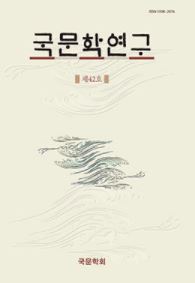본고는 유언호(兪彦鎬, 1730~1796)의 문집 『연석(燕石)』에 수행된 평점비평의 특징적 면모를 고구하고 그 의미를 밝힌 것이다. 현전하는 유일본 자료인 장서각본 『연석』을 주 텍스트로 삼아 논의를 진행하되, 학계에 새로 소개된 『연석』 관련 자료들을 참고하여 『연석』의 평점비평의 배경을 살폈다. 이를 통해 『연석』에 평점비평을 행한 주체가 박지원(朴趾源, 1737~1805)과 유한준(俞漢雋, 1732~1811)임을 확정하였다. 『연석』에 수행된 평점비평의 방식은 크게 권점(圈點)과 평어(評語)로 나뉘는 한편 붉은색과 푸른색의 두 종류로 구분된다. 붉은색이 박지원의 것, 푸른색이 유한준의 것이다. 『연석』에 사용된 권점과 평어는 명대(明代)의 대표적인 평점비평서인 모곤(茅坤, 1512~1601)의 『당송팔대가문초(唐宋八大家文鈔)』 및 18세기 조선에 유통되었던 평점비평서들에 보이는 방식들을 공유하면서도 차별된 성격을 내포한다. 특히 평어에서 대상 작품과 연관된 다른 작품 혹은 작가를 인용하여 제시하는 경우, 『연석』의 평어에서는 조선 시대 선배 문인 및 당대 문인으로 인용 범위가 확장되고 있다는 점이 이전과는 다른 특징이다. 그 밖에 평비자가 자신의 글을 인용하거나, 평비자가 알고 있는 사실 정보 및 관련 일화를 부연 서술하는 방식 등이 『연석』 평점비평 방식의 독특한 면모라고 할 수 있다. 이어서 평점비평의 배경과 방식을 바탕으로 ‘권점’과 ‘평어’의 측면에서 『연석』 평점비평의 의미를 밝혔다. 먼저, 『연석』이 ‘유언호-박지원-유한준’의 세 시각이 포개어진 텍스트라는 점에서 기호화된 ‘권점 비평’ 역시 독특한 비평 행위로 간주할 수 있음을 밝혔다. 이를 통해 권점 비평 행위를 대화적 지평에서 분석할 수 있다는 가능성을 모색했다. 다음으로는 평어를 통해 평비자가 자신을 ‘서명’한 경우를 살펴보았다. 이는 특히 박지원의 평어에서 확인된다. 한편 이 같은 성격의 평어는 평비자가 자신을 전면에 내세우는 것일 뿐만 아니라 대상 작품과 평어가 상호 조응하는 비평 방식임을 밝혔고, 이는 박지원이 『연석』에 평점비평을 하고 난 시점보다 이후에 행해진 『청성잡기(靑城雜記)』나 『풍석고협집(楓石鼓篋集)』에 보이는 이덕무(李德懋, 1741~1793), 이의준(李義駿, 1738~1798) 등의 평어에 보이는 비평방식과 유사함을 밝혔다. 요컨대 『연석』은 18세기 후반 조선 문인들 사이의 상호 평점비평이 성행하던 시기에 등장한 평점비평서로서 당대의 평점비평이라는 시대사적ㆍ문화사적 의미를 가늠할 수 있는 척도이자, 박지원과 유한준의 산문 비평의 실제와 그들의 비평가적 면모 및 지향을 파악할 수 있는 근거가 된다고 할 수 있다.
This paper is the first attempt at examining the characteristics and the significance of the pyeongjeom criticism(評點批評) in Yeonseok(燕石) written by Yu Eon-ho(兪彦鎬,1730∼1796). The argument of this paper is based primarily on analysis of the only existing manuscript copy of Yeonseok(燕石), which is currently stored in Jangseogak library, and also uses secondary information provided by another researcher regarding other newly discovered materials related to Yeonseok to scrutinize the background of the pyeongjeom criticism in Yeonseok and prove that the writers behind this pyeongjeom criticism are Park Ji-won(朴趾源,1737∼1805) and Yoo Han-joon(俞漢雋, 1732∼1811). The criticism presented in Yeonseok can be generally divided into two categories. One is ‘Kwonjeom’(圈點)(emphatic dots), and the other is ‘Pyeong-eoh’(評語)(critical words and phrases). The pyeongjeom criticism can also be distinguished by colour. Red is used to mark the criticism composed by Park Ji-won and blue is used to mark the criticism by Yoo Han-joon. The characteristics of the kwonjeom and pyeong- eoh used in Yeonseok can also be found in the Ming dynasty’s representative book of pyeongjeom criticism Selected Works of Writings by the Top Eight Great Writers of the Tang and Song Dynasties(唐宋八大家文鈔), written by Mao Kun(茅坤), and in the pyeongjeom criticism that circulated in the late 18th century of the Chosun Dynasty. However, even while sharing similar methods as these other examples, the pyeongjeom criticism in Yeonseok also has its own distinctive character. This thesis sheds light on both the shared methods and the distinctive aspects of the pyeongjeom criticism in Yeonseok. After analyzing the general features of kwonjeom and pyeong-eoh, this paper examines the way they function and interact within the text of Yeonseok. As kwonjeom is conveyed semiotically, it is difficult to decode its meaning, so many studies dealing with pyeongjem criticism have overlooked its function. However, this thesis evaluates the use of kwonjeom from the perspective of viewing it as a unique form of criticism and thereby demonstrates that Park Ji-won and Yoo Han-joon’s use of the kwonjeom can be considered as a dialogic effort. In regard to pyeong-eoh, this study examines how the critics Park Ji-won and Yoo Han-joon use their own writing from previous compositions as critical comments. This is especially true for Park Ji-won’s criticism. As a result, the pyeongjeom criticism in Yeonseok can be considered a unique style of criticism that engages in a dialogue with its subject text rather than offering a simple assessment, resembling the style of criticism practiced by a little later by writers like Lee Deok-mu(李德懋, 1741∼1793) and Lee Eui-jun(李義駿, 1738∼1798) in Cheongseongjapgi(靑城雜記) and Punseok-Kohyupjip(楓石鼓篋集). In conclusion, Yeonseok can be considered a means for gaining a sense of the historical and literary significance of the interactive style of pyeongjeom criticism which became popular practice in the late 18th century between Chosun literatures as well as an authoritative source of reference for gaining an understanding of Park Ji-won and Yoo Han-joon’s prose criticism and their critical demeanour and inclinations.
Ⅰ. 서론
Ⅱ. 『연석』 평점비평의 개관
Ⅲ. 『연석』 평점비평의 의미
Ⅳ. 결론
(0)
(0)
